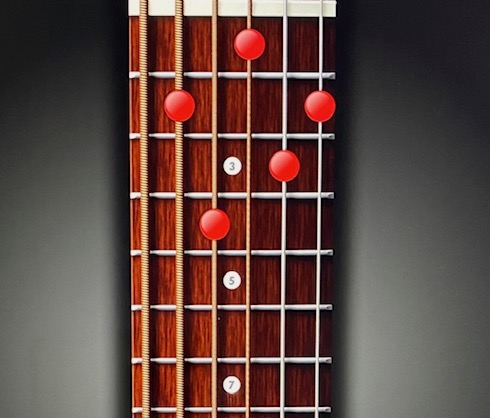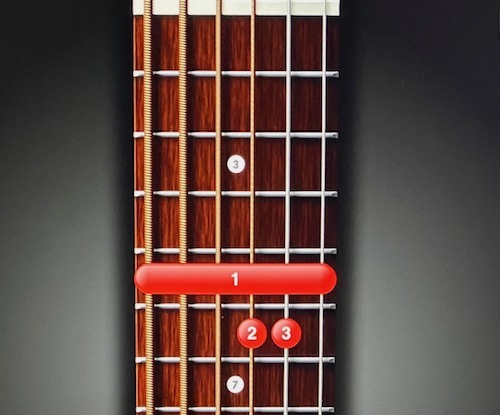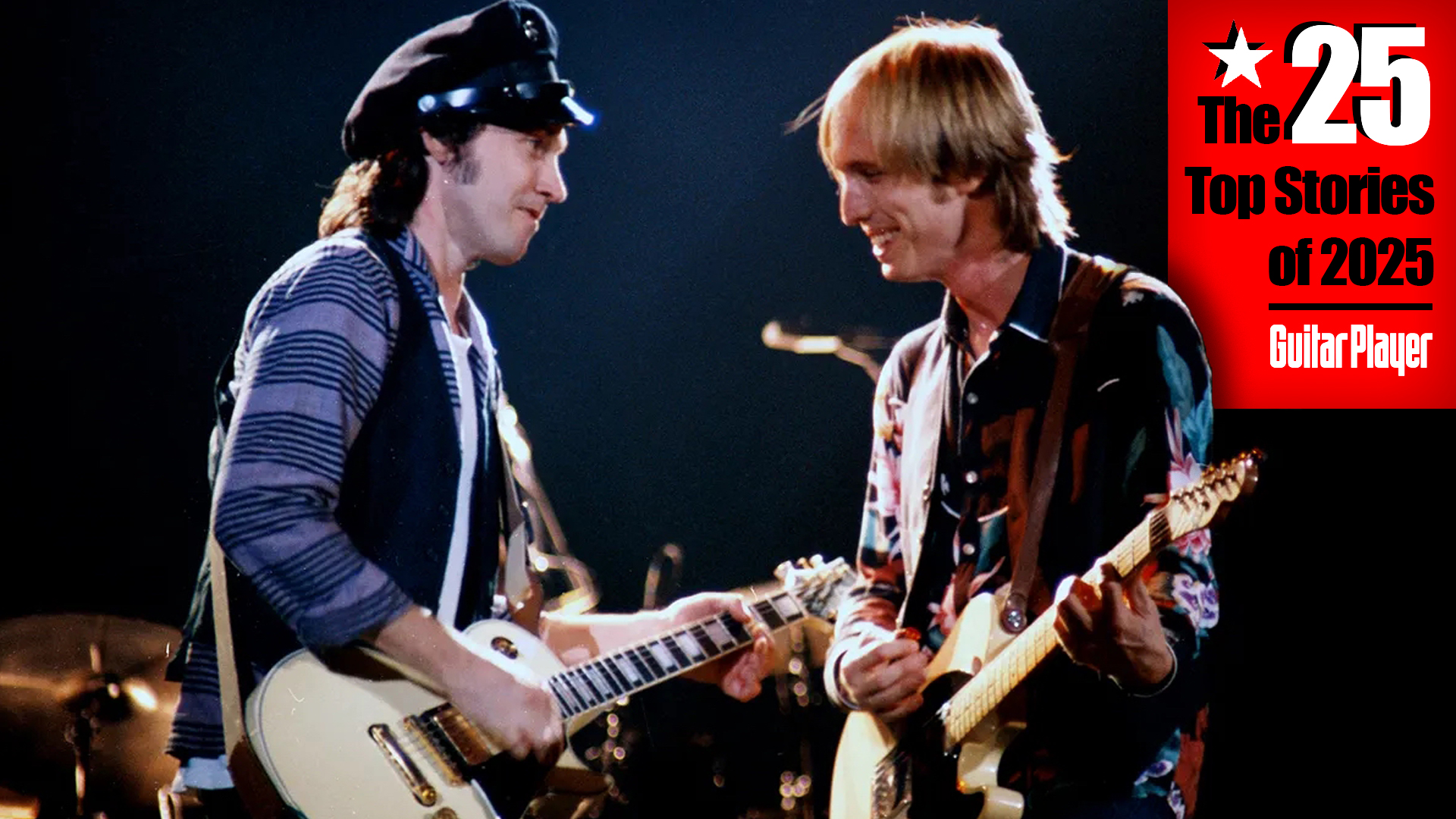"As much as I love gear and gadgets, there’s no substitute for what you can do with your fingers." Adrian Belew reveals six ways to change your guitar game right now, for free

Throughout his wildly eclectic and adventurous career, Adrian Belew has continually pushed the sound of the electric guitar to new heights. And if you think he’s reached his limit for experimentation, think again. “I’m still totally intrigued by the guitar,” he says. “There’s so much left for me to explore on the instrument. I’ve always gravitated toward new sounds, and I don’t think that will change. Each month there’s cool new pedals and devices to check out.”
Funnily enough, these days the man who found fame by making his Strat sound like jungle animals is finding just as much joy from playing an acoustic. “As much as I love gear and gadgets, there’s no substitute for what you can do with your fingers,” he says.
Belew has also been setting the bar higher for himself by learning Chet Atkins songs and classical pieces. “There’s even some challenging songs from my own catalog that I’d like to go back and relearn,” he says. “There are certain songs I play in concert a lot, but there’s others I haven’t touched in a long time. It gets overwhelming sometimes trying to remember them all, especially when they have complications like tunings and what not. Just recently, I went back and tried playing my song ‘Tango Zebra,’ and boy, it’s a tough one.” He laughs, then adds, “My goal is to sit around a campfire and play my songs on an acoustic guitar. Some of them are simple; most of them are not.”
Interested in taking your own playing somewhere different? Belew has some ideas for you (and he’s even provided some visuals).
TRY A NEW TUNING
“One way to push yourself into doing something you otherwise wouldn’t is by using an alternate tuning. And guess what? You can do it right now, and it won’t cost you a thing.
“I like alternate tunings that are simple to work out. For example, on my early solo records of the ‘80s, I sometimes tuned my G string up one step to an A. It's only one string, but being in the middle of the neck it changes everything. From the time I first taught myself how to play, I tried to make my own tunings. I’ve written many songs with one tuning I created way back when.”
All the latest guitar news, interviews, lessons, reviews, deals and more, direct to your inbox!
TRY TUNING YOUR GUITAR TO D A D E B E
“Tune the low E a whole step down to a D. Then tune the G string down a third to an E. This will sufficiently screw up all your go-to licks and chords and will hopefully break you out of habits while inspiring you to play something new.
“Let's try a few chords with this tuning. If you play an A sus shape like this [see diagram 1], it now sounds like this [diagram 2]. The beauty is in the voicing, which cannot be played in standard tuning. The same is true with this [diagram 3], which is a common Bm shape but now sounds like this [diagram 4] impossible voicing of an E9. Try this one — it’s a beautiful passing chord [diagram 5]. Or just play the harmonics on the 12 fret and listen to the richness.

Diagram 1

Diagram 2

Diagram 3

Diagram 4

Diagram 5
“You can do all kinds of things with different tunings. For the song ‘Twang Bar King,’ I detuned the top strings to be very loose and floppy, and that's how I played the springy solos in the song. Tunings are only as good as the inspiration they give you.”
LEARN A PIECE OF MUSIC THAT'S OUTSIDE YOUR COMFORT ZONE
“I recently stumbled upon a YouTube clip of Chet Atkins playing his first hit single, ‘Mr. Sandman,’ on a TV show from 1954. It's a completely different way of playing from what I'm used to, but it’s a style I have always admired. I was home on a two-month break between tours, so I decided to challenge myself and try to learn how to play it. I have to admit, it’s been very difficult, but at the time it’s also been fun and engrossing trying to learn the picking style the song requires.
“As though that weren’t enough, I also took on figuring out learning a Beatles piano song, ‘Martha My Dear,’ but I played it on guitar using the same thumb picking technique as the Chet Atkins piece. In addition, I tried to learn a classical guitar piece, which is very a very new area for me.
“Many times throughout the day I practice these pieces, and the rewards are considerable as I feel my execution improving. Right there is proof that there’s always something new to discover on the instrument.”
GOOGLE!
“If you're of a certain age — that is, if you’re very young — you may not appreciate all the gift progress has given us. Believe it or not, there was a time when the only way you could learn how to play something was by listening to records and trying to figure out how to mimic what you were hearing.
“Not anymore. What a gigantic advantage the internet has been. I know that's an obvious statement, but sometimes I'm still amazed at the continual wealth of knowledge and information we have at our fingertips. Who knew how much incredible music the world has created? I jump in the deep end of the internet pool as often as I have time for, perhaps too often, and I nearly always find something of interest.”
TRY A NEW PIECE OF GEAR OR NEW TECHNIQUE
“One of my favorite things search for on Google is new pieces of gear. YouTube makes the experience so much better because, without even leaving your home, you can hear what almost any piece of gear sounds like. Most manufacturers routinely offer demonstrations of their products online, and there are many sites that do so as well.
“Perhaps you’re like me in that the sound of a guitar is just as important as the notes being played. To that end, I search for new sounds or techniques as a source of inspiration.
“Finding a new sound or technique doesn't necessarily have to be expensive. For years I have had a starter guitar for kids called a Loog. It's cheap, very plain and small, and comes unassembled in a few pieces. You’re supposed to put it together with your child. It has three unwound high strings, one lipstick pickup and one wooden knob. The Loog had been languishing in my studio closet for a few years until one day I started messing with it.
“I tuned all three strings in unison to a high D note. Then I plugged it in, picked up a drumstick and started rolling the stick across the strings, kind of like I was bowing it. With a bit of delay added and the type of flourishes I played, it suddenly sounded like some sort of unknown Indian instrument. It was a gorgeous sound and a proper example of what I'm talking about. In fact, you can hear what it sounds like at the end of the song ‘The Power of the Natural World’ on my recent solo record, Elevator, available on Bandcamp.”
WORK ON YOUR MINDSET
“I think it’s important to ask yourself, ‘What does guitar playing mean to me? Am I happy with where I am as a guitarist? What purpose does guitar playing have in my life?’
“If you're someone who plays for your own enjoyment, you probably need to do nothing more than continue to enjoy. There's absolutely nothing wrong with that.
“If you're someone who plays guitar for a living but has yet to achieved the status you desire, I would suggest you continue to practice and learn. Take whatever may be relevant from my comments, and from what you read, and never give up. Stay focused on the music you love as much as possible, even if it's not what you play for your livelihood. Try to stay true to yourself.
“If you're fortunate enough to be employed as a studio player, touring musician, gear demonstrator or recording artist, always appreciate the position you have. Don't abuse it. Don't ever get jaded. Be humble. Clean your instrument and cherish it. And above all, love and respect your fans.”

Joe is a freelance journalist who has, over the past few decades, interviewed hundreds of guitarists for Guitar World, Guitar Player, MusicRadar and Classic Rock. He is also a former editor of Guitar World, contributing writer for Guitar Aficionado and VP of A&R for Island Records. He’s an enthusiastic guitarist, but he’s nowhere near the likes of the people he interviews. Surprisingly, his skills are more suited to the drums. If you need a drummer for your Beatles tribute band, look him up.
